Abstract
A novel class of highly abundant polypeptides with antifungal activity has been detected in cell walls of barley leaves. Similar polypeptides known as thionins occur not only in monocotyledonous but also in various dictoyledonous plants. The leaf-specific thionins of barley are encoded by a complex multigene family, which consists of at least 50-100 members per haploid genome. All of these genes are confined to chromosome 6. The toxicity of these thionins for plant pathogenic fungi and the fact that their synthesis can also be triggered by pathogens strongly suggest that thionins are a naturally occurring, inducible plant protein possibly involved in the mechanism of plant defence against microbial infections.
Keywords: cell wall protein, disease resistance, plant pathogen, thionin, plant defence, antifungal activity
Full text
PDF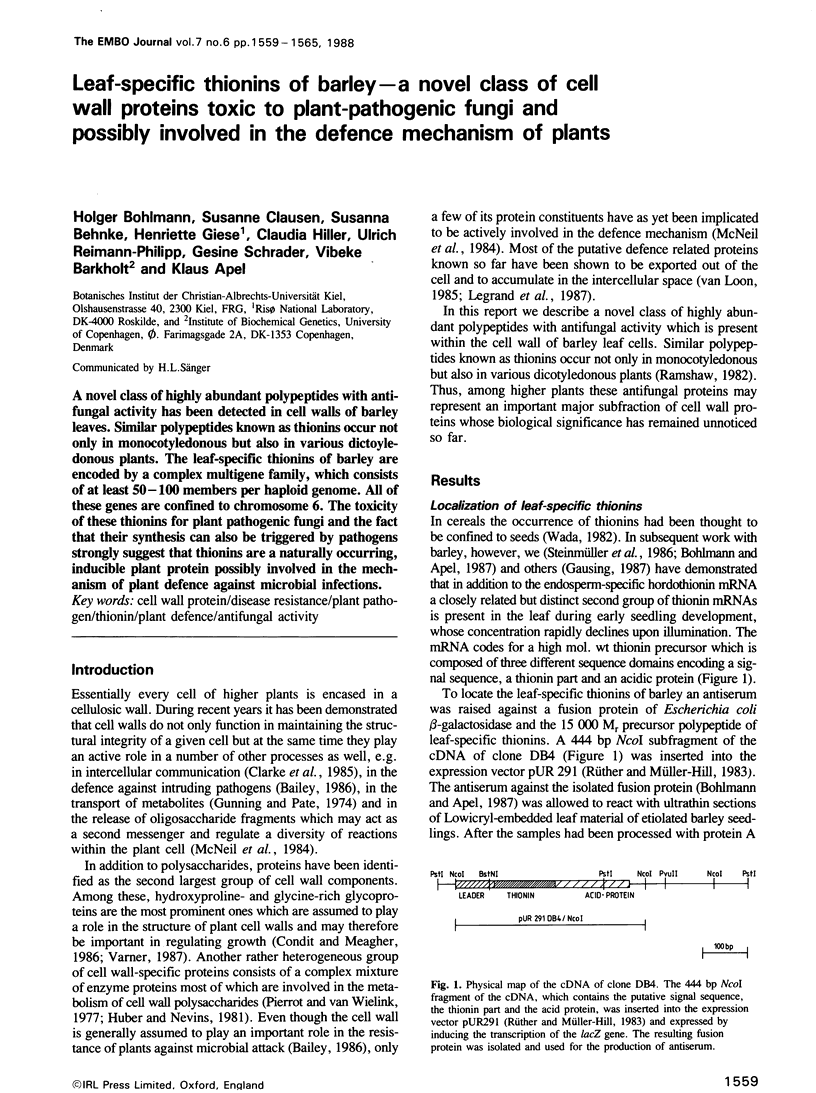
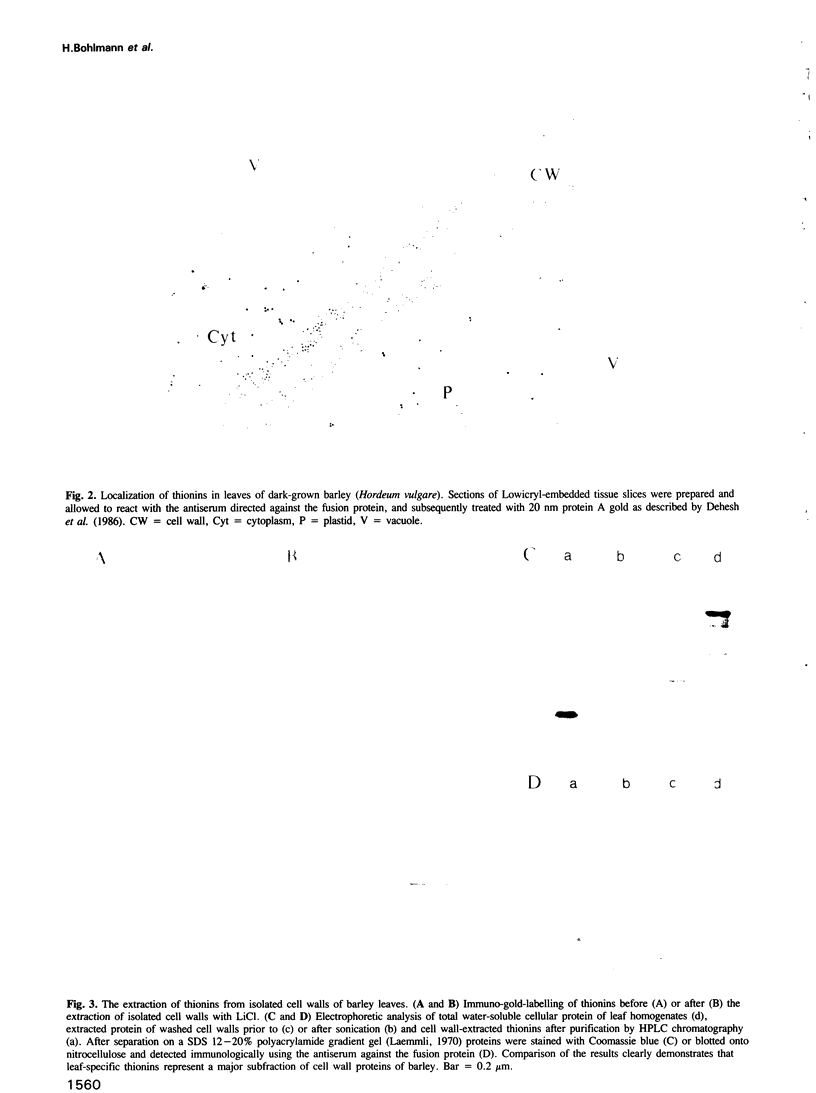
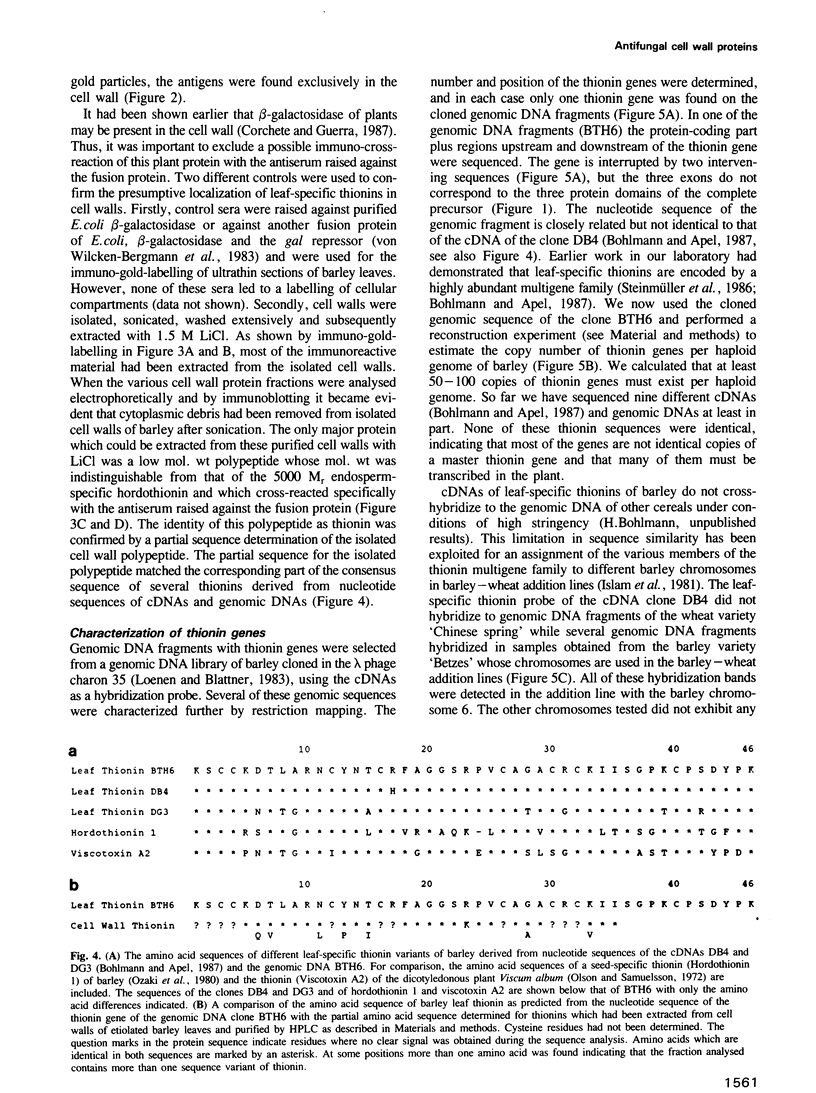
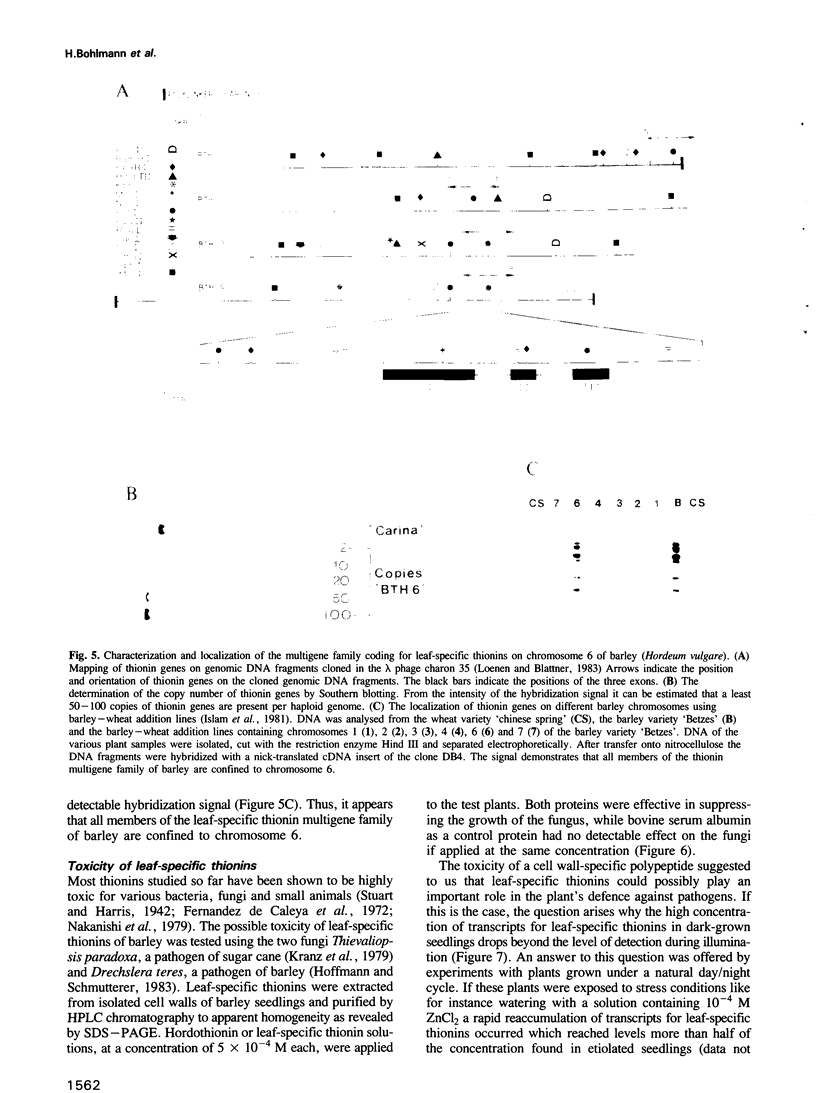
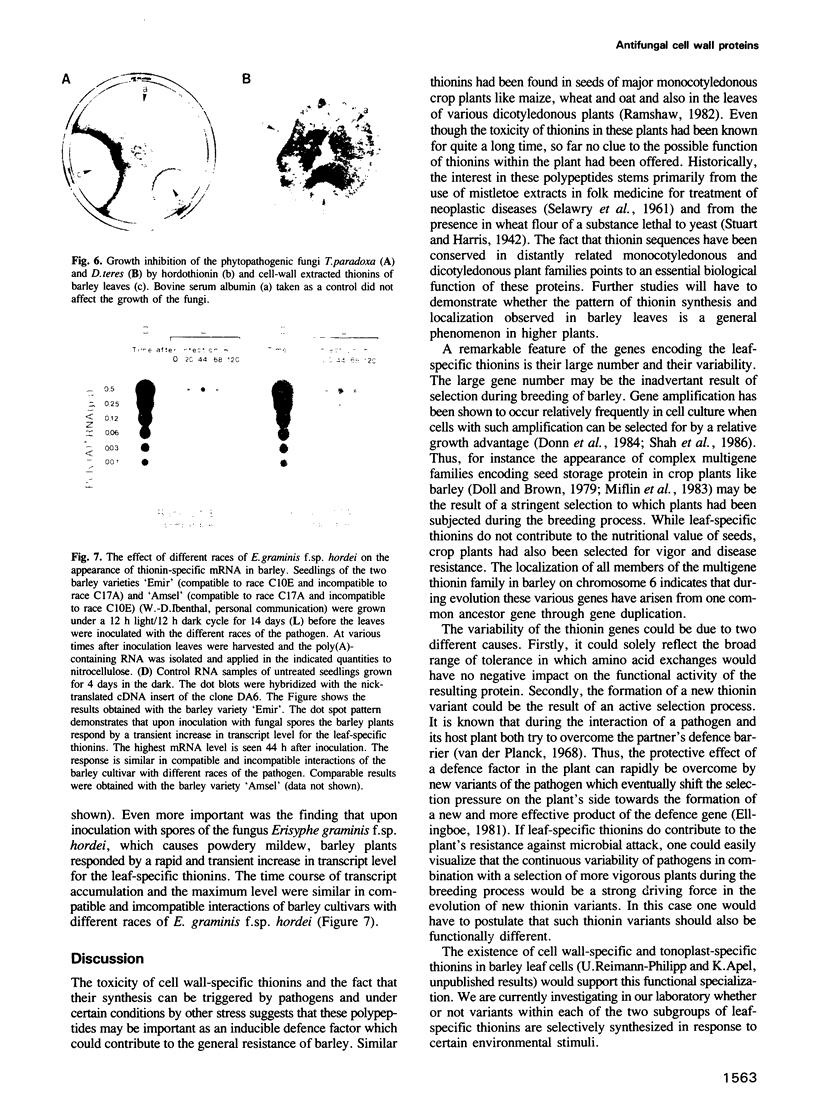
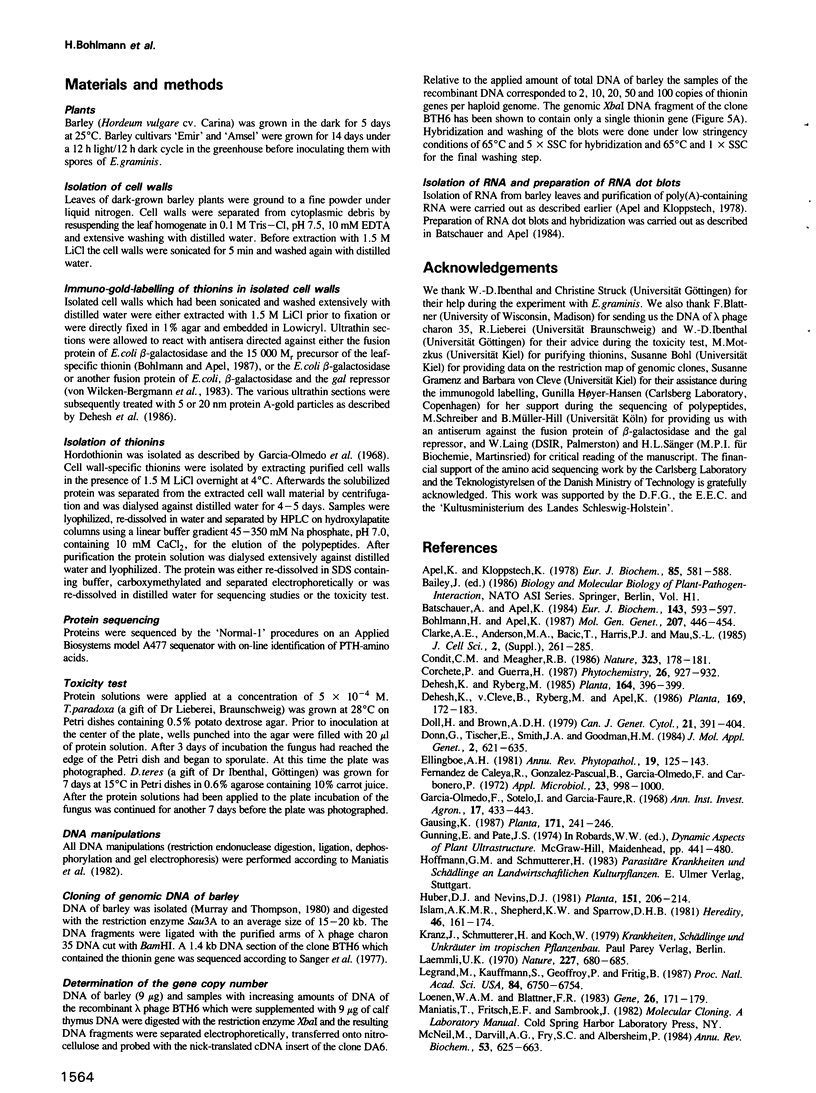

Images in this article
Selected References
These references are in PubMed. This may not be the complete list of references from this article.
- Apel K., Kloppstech K. The plastid membranes of barley (Hordeum vulgare). Light-induced appearance of mRNA coding for the apoprotein of the light-harvesting chlorophyll a/b protein. Eur J Biochem. 1978 Apr 17;85(2):581–588. doi: 10.1111/j.1432-1033.1978.tb12273.x. [DOI] [PubMed] [Google Scholar]
- Batschauer A., Apel K. An inverse control by phytochrome of the expression of two nuclear genes in barley (Hordeum vulgare L.). Eur J Biochem. 1984 Sep 17;143(3):593–597. doi: 10.1111/j.1432-1033.1984.tb08411.x. [DOI] [PubMed] [Google Scholar]
- Clarke A. E., Anderson M. A., Bacic T., Harris P. J., Mau S. L. Molecular basis of cell recognition during fertilization in higher plants. J Cell Sci Suppl. 1985;2:261–285. doi: 10.1242/jcs.1985.supplement_2.14. [DOI] [PubMed] [Google Scholar]
- Donn G., Tischer E., Smith J. A., Goodman H. M. Herbicide-resistant alfalfa cells: an example of gene amplification in plants. J Mol Appl Genet. 1984;2(6):621–635. [PubMed] [Google Scholar]
- Fernandez de Caleya R., Gonzalez-Pascual B., García-Olmedo F., Carbonero P. Susceptibility of phytopathogenic bacteria to wheat purothionins in vitro. Appl Microbiol. 1972 May;23(5):998–1000. doi: 10.1128/am.23.5.998-1000.1972. [DOI] [PMC free article] [PubMed] [Google Scholar]
- Laemmli U. K. Cleavage of structural proteins during the assembly of the head of bacteriophage T4. Nature. 1970 Aug 15;227(5259):680–685. doi: 10.1038/227680a0. [DOI] [PubMed] [Google Scholar]
- Legrand M., Kauffmann S., Geoffroy P., Fritig B. Biological function of pathogenesis-related proteins: Four tobacco pathogenesis-related proteins are chitinases. Proc Natl Acad Sci U S A. 1987 Oct;84(19):6750–6754. doi: 10.1073/pnas.84.19.6750. [DOI] [PMC free article] [PubMed] [Google Scholar]
- Loenen W. A., Blattner F. R. Lambda Charon vectors (Ch32, 33, 34 and 35) adapted for DNA cloning in recombination-deficient hosts. Gene. 1983 Dec;26(2-3):171–179. doi: 10.1016/0378-1119(83)90187-7. [DOI] [PubMed] [Google Scholar]
- McNeil M., Darvill A. G., Fry S. C., Albersheim P. Structure and function of the primary cell walls of plants. Annu Rev Biochem. 1984;53:625–663. doi: 10.1146/annurev.bi.53.070184.003205. [DOI] [PubMed] [Google Scholar]
- Murray M. G., Thompson W. F. Rapid isolation of high molecular weight plant DNA. Nucleic Acids Res. 1980 Oct 10;8(19):4321–4325. doi: 10.1093/nar/8.19.4321. [DOI] [PMC free article] [PubMed] [Google Scholar]
- Nakanishi T., Yoshizumi H., Tahara S., Hakura A., Toyoshima K. Cytotoxicity of purothionin-A on various animal cells. Gan. 1979 Jun;70(3):323–326. [PubMed] [Google Scholar]
- Olson T., Samuelsson G. The amino acid sequence of viscotoxin A2 from the European mistletoe (Viscum album L., Loranthaceae). Acta Chem Scand. 1972;26(2):585–595. doi: 10.3891/acta.chem.scand.26-0585. [DOI] [PubMed] [Google Scholar]
- Ozaki Y., Wada K., Hase T., Matsubara H., Nakanishi T., Yoshizumi H. Amino acid sequence of a purothionin homolog from barley flour. J Biochem. 1980 Feb;87(2):549–555. doi: 10.1093/oxfordjournals.jbchem.a132777. [DOI] [PubMed] [Google Scholar]
- Rüther U., Müller-Hill B. Easy identification of cDNA clones. EMBO J. 1983;2(10):1791–1794. doi: 10.1002/j.1460-2075.1983.tb01659.x. [DOI] [PMC free article] [PubMed] [Google Scholar]
- SELAWRY O. S., VESTER F., MAI W., SCHWARTZ M. R. [On the identification of the constituents of Viscum album. II. Tumor inhibiting substances]. Hoppe Seylers Z Physiol Chem. 1961 Jun 21;324:262–281. doi: 10.1515/bchm2.1961.324.1.262. [DOI] [PubMed] [Google Scholar]
- Sanger F., Nicklen S., Coulson A. R. DNA sequencing with chain-terminating inhibitors. Proc Natl Acad Sci U S A. 1977 Dec;74(12):5463–5467. doi: 10.1073/pnas.74.12.5463. [DOI] [PMC free article] [PubMed] [Google Scholar]
- Shah D. M., Horsch R. B., Klee H. J., Kishore G. M., Winter J. A., Tumer N. E., Hironaka C. M., Sanders P. R., Gasser C. S., Aykent S., Siegel N. R., Rogers S. G., Fraley R. T. Engineering herbicide tolerance in transgenic plants. Science. 1986 Jul 25;233(4762):478–481. doi: 10.1126/science.233.4762.478. [DOI] [PubMed] [Google Scholar]
- Steinmüller K., Batschauer A., Apel K. Tissue-specific and light-dependent changes of chromatin organization in barley (Hordeum vulgare). Eur J Biochem. 1986 Aug 1;158(3):519–525. doi: 10.1111/j.1432-1033.1986.tb09785.x. [DOI] [PubMed] [Google Scholar]
- von Wilcken-Bergmann B., Koenen M., Griesser H. W., Müller-Hill B. 72 residues of gal repressor fused to beta-galactosidase repress the gal operon of E. coli. EMBO J. 1983;2(8):1271–1274. doi: 10.1002/j.1460-2075.1983.tb01580.x. [DOI] [PMC free article] [PubMed] [Google Scholar]







